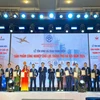The success of the initial public offerings (IPO) of the State-owned transport enterprises in the first quarter is likely to send out positive signals on the long-waited equitisation.
From January to March, five out of the nine State corporations under the Ministry of Transport managed to successfully offer shares to the public.
The Transport Engineering Design Inc sold all shares at 21,848 VND each, twice the initial price, generating 56.8 billion VND, or 2.7 million USD, for the State.
The Vietnam Waterway Construction Corporation gained 91 billion VND, or 4.3 million USD. The Civil Engineering Construction Corporation 4 (Cienco 4) got 226.5 billion VND, or 10.7 million USD.
Cienco 1 made 162 billion VND, or 7.7 million USD and the Thang Long Construction Corporation made 258.5 billion VND, or 12.2 million USD.
Four other corporations under the Ministry, however, failed to reach the target, including Cienco 5 which sold only 13.4 percent of the shares, Cienco 6 which sold 4 percent, the Waterway Construction Corporation which sold 36.3 percent and Vinamotor which sold 3 percent of the shares.
The Ministry of Transport is also speeding up the equitisation of units controlled by the Vietnam National Shipping Lines (Vinalines). The parent company of Vinalines is expected to issue an IPO by the first quarter, 2015.
None of the IPOs issued by the four corporations under the Ministry of Construction succeeded.
Deputy Head of the Steering Committee for Business Renovation and Development Pham Viet Muon said the strategic investor participation did help to make some of the IPOs successful. Those who failed did not have any strategic investors.
According to economic think-tank Vo Tri Thanh, one of the key things that the State-owned enterprises need to do to attract strategic investors is to improve information transparency and set up a committee for strict supervision of theequitisation process.
Economists suggested that the companies whose IPOs failed should shift to the joint stock model so as to improve administration and supervision, which would help their next IPO.
The Ministry of Finance plans to submit new regulations to boost equitisation and withdrawal of State capital.
In a draft to amend the 2005 Law on Enterprises on practices of State-owned enterprises (SOEs), the Ministry of Planning and Investment proposes to regulate periodic and upon-request information disclosure at SOEs. This shows a growing pressure to restructure this driver of the economy.
Vietnam plans to have 432 SOEs equitised during the 2014-15 period, or 216 enterprises per year. It is well on its way to carrying out a full-scale reform of the bloated state-owned enterprises. Between 1986 and 2013, the number of state-owned enterprises fell from 12,000 to 1,284.-VNA
From January to March, five out of the nine State corporations under the Ministry of Transport managed to successfully offer shares to the public.
The Transport Engineering Design Inc sold all shares at 21,848 VND each, twice the initial price, generating 56.8 billion VND, or 2.7 million USD, for the State.
The Vietnam Waterway Construction Corporation gained 91 billion VND, or 4.3 million USD. The Civil Engineering Construction Corporation 4 (Cienco 4) got 226.5 billion VND, or 10.7 million USD.
Cienco 1 made 162 billion VND, or 7.7 million USD and the Thang Long Construction Corporation made 258.5 billion VND, or 12.2 million USD.
Four other corporations under the Ministry, however, failed to reach the target, including Cienco 5 which sold only 13.4 percent of the shares, Cienco 6 which sold 4 percent, the Waterway Construction Corporation which sold 36.3 percent and Vinamotor which sold 3 percent of the shares.
The Ministry of Transport is also speeding up the equitisation of units controlled by the Vietnam National Shipping Lines (Vinalines). The parent company of Vinalines is expected to issue an IPO by the first quarter, 2015.
None of the IPOs issued by the four corporations under the Ministry of Construction succeeded.
Deputy Head of the Steering Committee for Business Renovation and Development Pham Viet Muon said the strategic investor participation did help to make some of the IPOs successful. Those who failed did not have any strategic investors.
According to economic think-tank Vo Tri Thanh, one of the key things that the State-owned enterprises need to do to attract strategic investors is to improve information transparency and set up a committee for strict supervision of theequitisation process.
Economists suggested that the companies whose IPOs failed should shift to the joint stock model so as to improve administration and supervision, which would help their next IPO.
The Ministry of Finance plans to submit new regulations to boost equitisation and withdrawal of State capital.
In a draft to amend the 2005 Law on Enterprises on practices of State-owned enterprises (SOEs), the Ministry of Planning and Investment proposes to regulate periodic and upon-request information disclosure at SOEs. This shows a growing pressure to restructure this driver of the economy.
Vietnam plans to have 432 SOEs equitised during the 2014-15 period, or 216 enterprises per year. It is well on its way to carrying out a full-scale reform of the bloated state-owned enterprises. Between 1986 and 2013, the number of state-owned enterprises fell from 12,000 to 1,284.-VNA



















